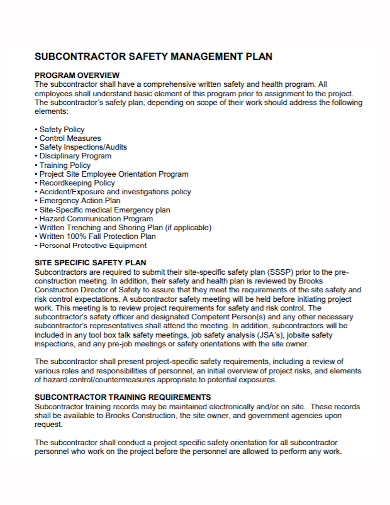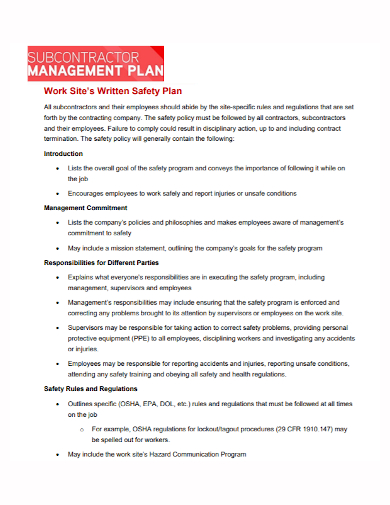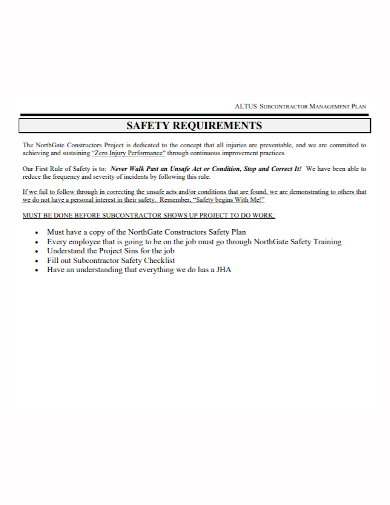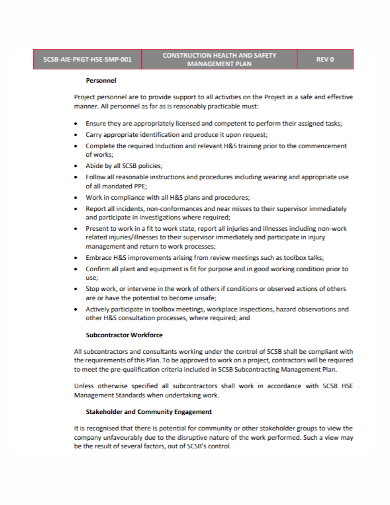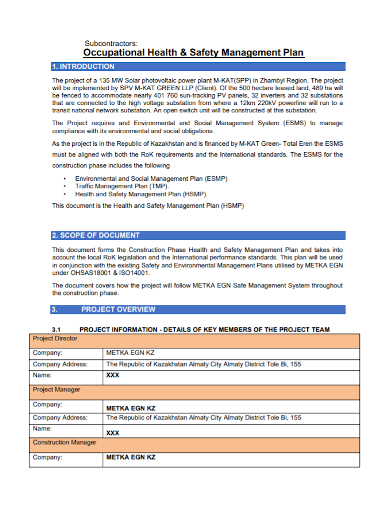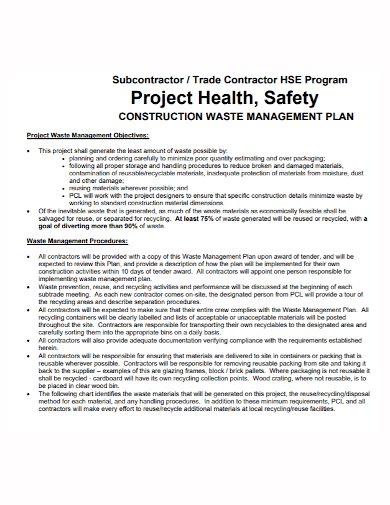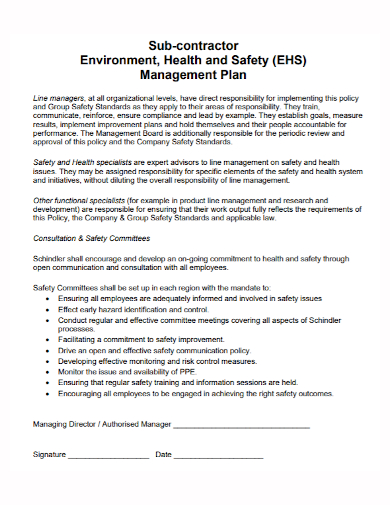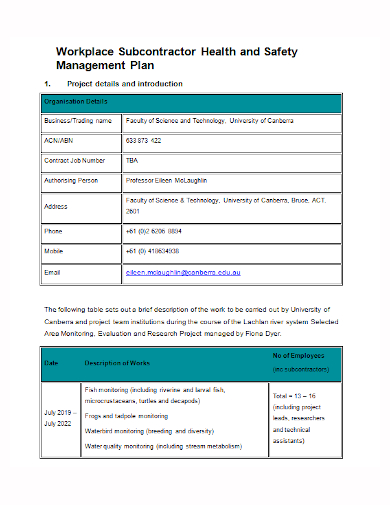In any business or organization, the safety of your workforce is the utmost priority. If you ensure a safe place to work in with no risk hazards, your employees are guaranteed to be more productive as this cultivates a healthy environment. This is even more important in construction projects, since everyday the workers are subjected to plausible risks and hazards— like falling debris, injuries, and accidents– that might cost them their life. Thus, you should implement risk assessments and action plans to ensure the safety of your workplace. If you’re a construction manager handling subcontractors and you’re looking for some assistance with this, look no further! In this article, we provide you with free and ready-to-use samples of Subcontractor Safety Management Plan in PDF and DOC formats that you could use for your convenience! Keep on reading to find out more.
10+ Subcontractor Safety Management Plan Samples
1. Subcontractor Safety Management Plan
2. Sample Subcontractor Safety Management Plan
3. Subcontractor Work Site Safety Management Plan
4. Subcontractor Safety Requirements Management Plan
5. Subcontractor Workforce Safety Management Plan
6. Subcontractor Health and Safety Management Plan
7. Subcontractor Occupational Safety Management Plan
8. Subcontractor Project Safety Management Plan
9. Subcontractor Safety Waste Management Plan
10. Subcontractor Environment Safety Management Plan
11. Workplace Subcontractor Safety Management Plan
What Is a Subcontractor Safety Management Plan?
A Subcontractor Safety Management Plan is a framework for identifying dangers, vulnerabilities, and risks in subcontractors as well as for putting mitigation measures in place to help achieve the greatest possible level of safety performance. Workers need strategies and measures that allow businesses to regularly identify and manage health and safety hazards and reduce accident potential as part of a Safety Management Plan in any subcontractor field. A sound health and safety management plan can help reduce the likelihood of an accident and keep employees safe at work. It’s unacceptable for anyone to be harmed or killed while doing their job. Putting in place a health and safety management system that can both cut down on accidents and improve employee morale.
How to Make a Safety Management Plan
A safety management plan for subcontractors should show how the project’s procedures, practices, and safety management are integrated with the subcontractor health and safety’s requirements. If you want a robust and well thought-out safety management strategy, choose one of the excellent templates we’ve provided above so that you don’t have to go through the hassle of drafting one from scratch. Other than that, check out these elements to guide you in creating one of your own:
1. Description of the project
This component of the plan should include a description of the project’s important characteristics based on the project’s major stages, as well as any potential dangers or risks. This section of the plan should be project-specific, outlining important facts such as the project name, purpose, duration, stages, and safety issues at each point of the project’s lifecycle. In addition, the location and layout of the site, as well as the interfaces to be considered, are part of this.
2. Consultation, orientation, and instruction
In this part, strategies for internal consultation, effective information transmission, and the decision-making process should be developed. Interfaces between contractors should describe how consultations will be coordinated and recorded. Whether it’s a direct or indirect impact on people’s health and safety, the major contractor must discuss, cooperate and coordinate with subcontractors and others on issues of work health and safety.
3. Duties and responsibilities
From the tendering process until contract fulfillment, this section should explain the health and safety obligations of all project staff. This section, in particular, should specify who has authority to make health and safety-related decisions and actions, and under what conditions. All subcontractors’ names, positions, and authority levels must be listed in the explanation of safety obligations. Names, job titles, contact information, and health and safety duties and responsibilities associated with the project should be included in subcontractor information.
4. Identify hazards, assess them, and take steps to minimize their impact
This section of the project’s subcontractor health and safety management plan should outline the process for identifying potential health and safety hazards, assessing those risks, and defining the control measures to be applied. In order to control the threats most effectively and efficiently, a procedure must be devised and implemented. As the main contractor, it is your responsibility to ensure that all potential hazards have been addressed. If this is not feasible, the major contractor must manage risk by taking steps to reduce harm to the barest minimum.
FAQs
Who is liable for the health and safety of a subcontractor?
Contractors are accountable for their own health, safety, and actions, but subcontractors will carry out obligations on their behalf. Subcontractors can be either individuals or organizations. However, a contractor’s employees are not considered subcontractors; they must be treated as completely independent entities instead.
What are the dangers of using subcontractors?
All subcontractors, regardless of field, face a few primary kinds of risk. Financial risks include things like credit, payment, cash flow, and insurance; political/regulatory risks include things like employment, lien, and contract law concerns, as well as regulatory and administrative law risks; and finally, legal hazards include.
How much responsibility do subcontractors have for their own training?
Your role extends to making sure subcontractors receive any training or instruction they require, as well as having a written copy of your risk assessment and information of your safety procedures available to them.
Finally, putting in place a safety management system can assist cut down on accidents while also boosting employee morale. Involving employees in safety problems benefits companies over the long term. According to research, businesses can expect less risk-averse employees who are more productive, as well as a decrease in the number of accidents. To help you get started, download our easily customizable and comprehensive Subcontractor Safety Management Plan today!
Related Posts
FREE 11+ Sample Construction Contractor Agreement
FREE 10+ Quality Assurance Report Samples
FREE 10+ Non Conformance Report Samples
FREE 10+ Contractor Handbook Samples
FREE 9+ Sample Subcontractor Agreement
FREE 9+ Cleaning Company Profile Samples
FREE 8+ Contractor Management Policy Samples
FREE 5+ Safety Contract Samples
FREE 48+ Contract Agreement Templates
FREE 43+ Sample Work Plan
FREE 15+ Construction Company Profile Samples
FREE 10+ Consultant Scope of Work Samples
FREE 10+ Pre-Construction Services Agreement Samples
FREE 9+ Field Engineer Job Description Samples
FREE 3+ Contractor Business Plan Samples

